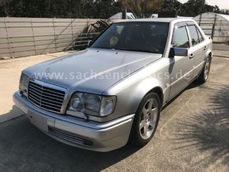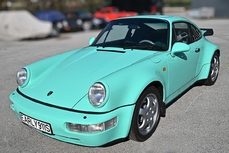Mercedes-Benz 500 w124 1993
General description :
This unique Mercedes W 124 E500 was delivered in Japan in January 1991. The vehicle has been extensively overhauled in recent years and returned to its original delivery condition and black leather. This is fully documented and can be proven by invoices. The complete history of the past years is also documented and traceable. The vehicle is offered with a new TUV and Classic Data report FIN WDB1240361B852357 199U BLUE BLACK - METALLIC PAINT 241 DRIVER'S SEAT LEFT ELECTRICALLY ADJUSTABLE WITH MEMORY 242 DRIVER'S SEAT RIGHT. ELECTRICALLY ADJUSTABLE WITH MEMORY 271A LEATHER PERFORATED BLACK 291 AIRBAG FOR DRIVER AND PASSENGER 300 STORAGE BOX IN STORAGE TRAY AT THE FRONT 412 ELECTRICALLY SLIDING AND LIFTING ROOF IN STEEL 441 STEERING COLUMN ELECTRICALLY ADJUSTABLE 540 ELECTRICAL ROLLER BLIND FOR REAR WINDOW 570 FOLDABLE ARMREST AT THE FRONT 581 AUTOMATIC AIR CONDITIONING 592 HEAT-INSULATING GREEN GLASS ALL AROUND, HEATED REAR WINDOW, BELT FILTER 620 EXHAUST GAS CLEANING SYSTEM 855 873 HEATED DRIVER'S SEAT LEFT AND RIGHT The vehicle offered here is offered on behalf of a customer. Please understand that a viewing is only possible by appointment - by email: mh@early911s.de or mobile: 0049 172 88 40 640. We have a vehicle inventory of over 400 vehicles. Errors and changes reserved.
Projectnumber: 2051
Projectnumber: 2051
Mileage: 74.323 km
Color: Blauschwarzmetallic
Interior Color: Black
Condition: Original Condition
Roadworthy: yes
Damage unrepaired: no
Accident damaged: no
Steering Wheel: LHD
1993 Mercedes-Benz 500 w124 is listed for sale on ClassicDigest in Wuppertal by EARLY 911S Dipl. Wirting. Manfred Hering for €79900.
Car Facts
Car type : Car Make : Mercedes-Benz Model : 500 w124 Engine size : 0.0 Model Year : 1993 Sub type : Sedan Color : Black Color type : Metallic Location : Westring 416-418 42329 Wuppertal, Germany Vehicle Registration : Undefined
79900 €
Seller Information
Early 911S Dipl. Wirting. Manfred Hering
EARLY 911S Dipl. Wirting. Manfred Hering
+49 (0)202 769220
EARLY 911S Dipl. Wirting. Manfred Hering
+49 (0)202 769220
Market Prices for Mercedes-Benz 500 w124 from 2023 to 2025
Months
Mercedes-Benz 500 w124 Selling Time to Price Correlation
0
6
12
18
24
30
36
42
48
54
0
200000000
400000000
600000000
800000000
1000000000
1200000000
ClassicDigest Market-O-Meter for Mercedes-Benz 500 w124
Moderate Blue Chip Chart Busters
People who viewed this Mercedes-Benz 500 w124 also viewed similar Mercedes-Benz listed at ClassicDigest
Other cars listed for sale by this dealer
About Mercedes-Benz
In the annals of automotive history, the journey of Mercedes-Benz is a tale that unfolds with the ingenuity of its founding pioneers. In the year 1886, Karl Benz crafted the Benz Patent Motorwagen, a creation that would go down in history as the world's inaugural automobile. Unbeknownst to him, this moment marked the genesis of what would evolve into the most illustrious premium car manufacturer globally. The financial underpinning of this pioneering venture, interestingly, was provided by Karl Benz's wife, Bertha Benz, demonstrating a remarkable partnership that would set the tone for Mercedes-Benz's legacy.A parallel narrative emerged not far away, as Daimler-Motoren-Gesellschaft, founded by Gottlieb Daimler and Wilhelm Maybach, entered the scene. In 1901, they unveiled their automobile under the now-famous moniker "Mercedes," meaning "godsend" in Spanish. This name was bestowed upon the car at the behest of Emil Jellinek's daughter, the distributor for Daimler-Motoren-Gesellschaft. The wheels of innovation were set in motion.
Fast forward to 1926, a pivotal year that witnessed the merger of Daimler with Benz & Cie., culminating in the birth of Daimler-Benz. The amalgamation saw the adoption of "Mercedes-Benz" as the distinguished trademark for their automobiles, fusing the legacies of two visionary entities into one.
Contrary to perceptions of conservatism, the trajectory of Daimler-Benz unfolds as a chronicle of industry firsts. From the introduction of the honeycomb radiator to the float carburetor, and the pioneering implementation of four-wheel brakes in 1924, Daimler-Benz consistently pushed the boundaries of automotive innovation. The diesel-powered Mercedes-Benz 260 D in 1936 marked the inception of diesel engines in passenger cars. The iconic Mercedes-Benz 300SL Gullwing made history as the first car with direct fuel injection, albeit the Gutbrod's tiny 2-stroke engine can claim precedence.
Safety innovations became a hallmark, with Béla Barényi's patented safety cell design in the "Ponton"-models in 1951, featuring front and rear crumple zones. The W116 450SEL 6.9 saw the introduction of the Anti-Lock Brake system (ABS), another pioneering safety feature. From the first production airbags and beyond, the legacy of "firsts" continued to be etched into the fabric of Daimler-Benz.
Over its centennial journey, Mercedes-Benz has not merely produced cars but has sculpted automotive icons. The SSKL, 710 SSK Trossi Roadster, 770K Grosser, 540K Spezial Roadster, 300SL Gullwing, w100 600 Pullman, w111 280SE 3.5 Flachkühler, w113 230SL Pagoda, w109 300 SEL 6.3, and w201 2.3-16 Cosworth stand testament to the brand's commitment to engineering excellence.
The roaring Silver Arrows, or "Silberpfeile," including the W 25, W 125, W154, W165, and W196, created a legacy of dominance on the racetrack. These machines were not merely cars; they were expressions of precision, speed, and an indomitable spirit that left their competitors in the dust.
As Mercedes-Benz marches into the future, it does so not just as an automaker but as a custodian of a legacy, a torchbearer of innovation, and a beacon of automotive excellence. The road ahead is sure to witness the continued fusion of cutting-edge technology, timeless design, and an unwavering commitment to setting new standards in the world of automobiles.
One luminary figure who left an indelible mark was Béla Barényi, often heralded as the "father of passive safety" for his pioneering work in safety engineering. His patented safety cell design, featuring front and rear crumple zones, became a hallmark of Mercedes-Benz's commitment to occupant safety, setting new standards that reverberated throughout the automotive world.
Moving through the chronicles, the collaborative genius of Wilhelm Maybach, alongside Gottlieb Daimler, laid the foundation for Daimler-Motoren-Gesellschaft. Their innovations not only birthed the first Mercedes but established a culture of relentless pursuit of technological excellence that remains integral to Mercedes-Benz's DNA.
In the post-merger era of 1926, Ferdinand Porsche emerged as a prominent figure within Mercedes-Benz. His work on the Mercedes-Benz S-Type, a supercharged race car, garnered acclaim and set the stage for a legacy that extended far beyond the marque. Porsche's impact would later extend to his eponymous company, but his influence at Mercedes-Benz during those formative years was pivotal.
As the 20th century progressed, the legendary Rudolf Uhlenhaut emerged as a key figure. Uhlenhaut, an accomplished engineer and the driving force behind the iconic Silver Arrows, played a crucial role in Mercedes-Benz's dominance in motorsports. His engineering prowess and attention to detail were instrumental in creating some of the most formidable racing cars of the era.
In the latter half of the century, figures like Bruno Sacco, the head of design at Mercedes-Benz from 1975 to 1999, left an indelible imprint on the brand's aesthetic identity. Sacco's design philosophy, characterized by clean lines and timeless elegance, shaped iconic models like the W126 S-Class and the W201 190E, solidifying Mercedes-Benz's reputation for luxury and sophistication.
The narrative would be incomplete without acknowledging the contributions of engineers like Hans Scherenberg, whose leadership in the 1970s ushered in a new era of technological innovation at Mercedes-Benz. Scherenberg's tenure saw the development of groundbreaking technologies, including the Anti-Lock Brake system (ABS) and the introduction of airbags in production cars.
























